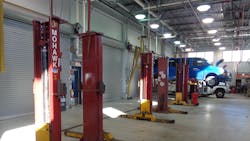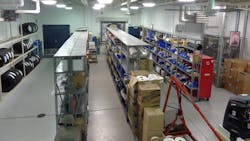People and software power Connecticut's public fleet efficiency
Shops at the State of Connecticut’s Department of Administrative Services (DAS) run like clockwork and there’s no doubt why they need to. The department provides 90 state agencies with a variety of fleet services, a responsibility that includes maintaining 3,600 vehicles and performing more than 500 preventive maintenance tasks a month. This requires a mix of knowledgeable personnel and fleet management software.
“We operate like a leasing company,” said Ed Guelfi, the department’s assistant director of state fleet operations. “We order vehicles for agencies and provide them along with maintenance services for a fixed cost over a specified term. We also field a fleet of loaner vehicles to meet their needs when one of their units is in the shop.”
The fleet division at DAS operates three shops in the state and has a total staff of 38 people, including technicians, service writers, and administrative and parts personnel.
“Our largest centrally located shop is as big as the other two facilities combined, but we’re staffed according to the number of vehicles that are serviced at each location,” Guelfi explained. “We maintain a balance across the operation so we can meet our goal of averaging 138 scheduled PMs per week.”
Understanding the fleet composition, and narrowing to fewer makes and models, are vital to meeting that target and ensuring the technicians can keep up with demand.
“It’s easier to be proactive about maintenance when you know the vehicles in your fleet,” Guelfi said. “The bulk of our agencies operate light-duty sedans, SUVs, and pickups from Ford, GM, and Stellantis. By focusing on models from specific manufacturers we can standardize and improve our maintenance practices. Common specs make our technicians more proficient because they’re knowledgeable about the vehicles, and they help keep our parts inventory costs in check.”
The DAS fleet has not been significantly impacted by recent shortages for routine maintenance parts, although some specialty items have taken a considerable amount of time to receive.
“We try to use OEM parts exclusively, and to keep our inventory volume low by turning it over regularly,” Guelfi said. “Before the pandemic created supply issues, our inventory was renewed about every three weeks.”
Despite rampant parts shortages over the last year, DAS has not experienced the vendor delays many fleets have reported, due in large part to one secret weapon.
“We’re also fortunate to have a parts manager who’s been in the industry for a long time and has a long list of sources,” Guelfi said. “The value of having someone like that on your staff is even more apparent today.”
Along with supplying parts, dealers also support the maintenance operation with warranty work. In some cases, the shops have been authorized by OEMs to make covered repairs. Additionally, the operation uses software supplied by manufacturers to diagnose and repair vehicles.
DAS shops also maintain loaner fleets, including 90 vehicles at its largest facility. The 2013 and 2014 models are used by agency personnel when their assigned vehicle may be in the shop for a longer period of time. For shorter service intervals, the facilities have workstations that state employees can use.
Digital tools
Streamlining service operations is important for achieving maximum uptime, Guelfi noted. The DAS fleet maintenance operation also relies on Chevin FleetWave software to accomplish that objective, he added. The solution has been in place at the department since 2017.
“FleetWave is a shop floor system for technicians and service writers and a management tool rolled into one,” Guelfi said. “We use it to build KPIs that we can see on a dashboard to track repair orders and service progress and address any bottlenecks that prevent us from completing the number of PMs we need to schedule weekly.”
After joining DAS in 2019, Guelfi immediately found another valuable use for FleetWave.
“The system hadn’t been set up to consolidate models,” Guelfi explained. “For example, the same vehicle may come in many different trims and each of those was a separate group. Including the Connecticut State Police fleet, which we also source, it took roughly 18 months to review every vehicle VIN in FleetWave to identify and correct 5,500 vehicles.”
FleetWave is also proving its value at the DAS fleet operation for tracking odometer readings and an average of 30,000 fuel transactions per month. In the near future, the software will be enabled to communicate with the Geotab GO9 telematics devices being fitted on the entire fleet.
“Manual daily odometer readings were often inaccurate so we’re working with Geotab and Chevin to develop an API,” Guelfi explained. “The connected solutions will create a very robust program for determining replacement plans.”
Using state contracts, the DAS fleet operation sources replacement vehicles based on mileage, maintenance data, and agency needs. The pricing, along with projected service requirements and residual values, has traditionally led to a six- to seven-year replacement cycle for most light-duty units. Currently, however, pandemic-driven changes in agency operations and issues with the supply of new vehicles have impacted that process.
“With manufacturers pushing build and delivery dates out by a year or more, we’ve had to extend the service life of vehicles in our fleet,” Guelfi said. “The silver lining has been that agency employees have spent less time on the road and at the office so mileage has gone down significantly. With less usage we can keep vehicles longer without raising maintenance costs.
“We’re also focused on helping DAS agencies right-size their fleets by using more shared and pool vehicles,” Guelfi added. “When the dust finally settles, we believe we will have a smaller fleet, and that will save help save money for everyone.”
About the Author

Seth Skydel
Seth Skydel, a veteran industry editor, has more than 36 years of experience in fleet management, trucking, and transportation and logistics publications. Today, in editorial and marketing roles, he writes about fleet, service, and transportation management, vehicle and information technology, and industry trends and issues.

